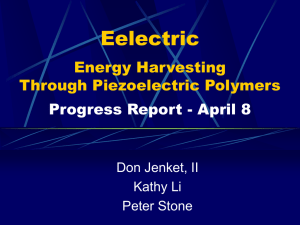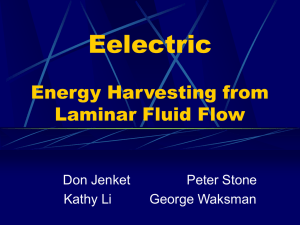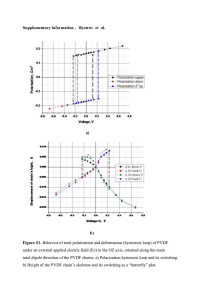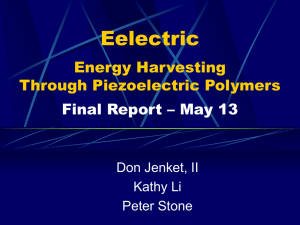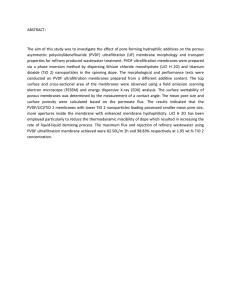Formal Design Review
advertisement
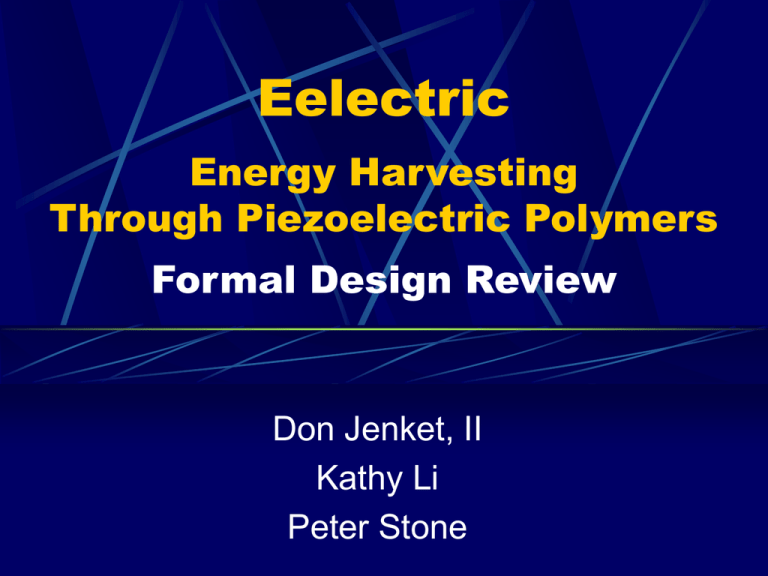
Eelectric
Energy Harvesting
Through Piezoelectric Polymers
Formal Design Review
Don Jenket, II
Kathy Li
Peter Stone
Presentation Overview
Project Goals
Choice of Materials
Choice of Processing Techniques
Device Architecture
Future Tests
Revised Timeline
March 11, 2004
Eelectric
Formal Design Review
Objective
DARPA Objective: Convert mechanical energy
from a fluid medium into electrical energy.
Fluid flow creates oscillations in an eel body
Creates strain energy that is converted to AC
electrical output by piezoelectric polymers
AC output is stored and/or utilized
3.082 Objective: Harness enough power from
air flow to operate a L.E.D.
March 11, 2004
Eelectric
Formal Design Review
PVDFPoly(vinylidene
fluoride)
F
H
C
C
F
H
n
Properties
Chemically
Inert
Flexible
High
Mechanical Strength
Production
React
HF and methylchloroform in a refrigerant gas
Polymerization from emulsion or suspension by free radical
vinyl polymerization
References: http://www.psrc.usm.edu/macrog/pvdf.htm, Accessed on: 3-9-04; Piezoelectric SOLEF PVDF Films. K-Tech Corp., 1993.
March 11, 2004
Eelectric
Formal Design Review
Piezoelectric PVDF
Molecular Origin
Fluorine atoms draw electronic density away from carbon
and towards themselves
Leads to strong dipoles in C-F bonds
Piezoelectric Model of PVDF (Davis 1978)
Piezoelectric activity based upon dipole orientation within
crystalline phase of polymer
Need a polar crystal form for permanent polarization
a-phase (antiparallel dipoles)
b-phase
(piezoelectric)
Reference: Davis, G.T., Mckinney, J.E., Broadhurst, M.G., Roth, S.C. Electric-filed-induced phase changes in poly(vinylidene fluoride). Journal of Applied Physics
49(10), October, 1978.
March 11, 2004
Eelectric
Formal Design Review
Piezoelectric PVDF
Poled by the Bauer Process
Biaxially stretch film: Orients some crystallites with their
polar axis normal to the film
Application of a strong electric field across the thickness of
the film coordinates polarity
Produces high volume fractions of b-phase crystallites
uniformly throughout the poled material
Selected Properties of 40 mm thick bioriented PVDF
Electromechanic coupling factor
0.11
Young’s Modulus
~2,500 MPa
Melting Point
175º C
Depoling Temperature
90º C
Table courtesy of K-Tech Corporation
Reference: Piezoelectric SOLEF PVDF Films. K-Tech Corp., 1993.
March 11, 2004
Eelectric
Formal Design Review
Tensile Testing of PVDF
Clamp
Rubber
PVDF
Cross-sectional Area of the
Film Tested: 1 cm X 40
microns = 4 X 10-7 m2
Measured strain: .063
Force at .063 strain: 3.95
lbs.
E = s e-1
Elastic Modulus Calculated:
2.56 GPa
March 11, 2004
Eelectric
Formal Design Review
Electrodes and Wires
Desired Properties
Electrodes
High Conductivity
Flexibility
Won’t oxidize
Wires
Ease of Attachment
Flexibility
The Process
Attach Electrodes using RF Magnetron Sputtering
Sputter 40 nm thick Gold electrodes on sample
Attach 3 mil copper wire with silver paste
March 11, 2004
Eelectric
Formal Design Review
Schematic of Sputtering
Sample Holder
Rotates
Sample Holder;
Sample faces down
Vacuum Pump
Load-Lock Chamber
Load-Lock Arm
Vacuum Pump
Main
Chamber
Sputter Guns
Adapted From: Twisselmann, Douglas J. The Origins of Substrate-Topography-Induced Magnetic Anisotropy in Sputered Cobalt Alloy Films. MIT Doctoral Thesis, February, 2001
March 11, 2004
Eelectric
Formal Design Review
Sputtering Apparatus
Sample Holder
Load-Lock
Chamber
Vacuum Pump
March 11, 2004
Main Chamber
Eelectric
Formal Design Review
Sputtering Target
March 11, 2004
Eelectric
Formal Design Review
“Eel Tail” Schematic
6-10 cm
2 cm
Top View
Cu Wire
Gold Electrode
Cu Wire
0.04 mm
Silver paste
6-10 cm
2 cm
Side View
March 11, 2004
Front View
Eelectric
Formal Design Review
Air Flow Testing of Eel Tail
For cost purposes, used unpoled PVDF
Thickness of PVDF film: 74 mm.
Can visually inspect eel oscillations
Wave forms
Estimate flexure and strain
Tested 2 cm by {5,6,7,8,9,10} cm tails
Copper “Fin”
Fan
PVDF
2 cm
Length= 5-10 cm
March 11, 2004
Eelectric
Formal Design Review
Air Flow Testing of Eel Tail
2cm x 6cm PVDF
March 11, 2004
Eelectric
Formal Design Review
Air Flow Testing of Eel Tail
2cm x 10cm PVDF
March 11, 2004
Eelectric
Formal Design Review
Piezoelectric Response
in Air Flow
2cm x 6cm Piezoelectric PVDF
March 11, 2004
Eelectric
Formal Design Review
Estimation of
Piezoelectric Response
If we model the tail as a cantilever:
V = 3/8 * (t/L)2 * h31 * dz,
t= thickness; L = Length; dz = bending radius and
h31 = g31*(c11 + c12)+ g33*c13
g31 = 6*10-12/11eo [V*m/N] c11 = 3.7 GN*m-2
g33 = -0.14 [V*m/N]
c12 = 1.47 GN*m-2
dz = 3 cm
c13 = 1.23 GN*m-2
L = 6 cm
t = 40 mm
Equation taken from: Herbert, J.M., Moulson, A.J. Electroceramics: Materials, Properties, Applications. Chapman and Hall: London, 1990.
Piezoelectric Constants taken from: Roh, Y. et al. Characterization of All the Electic, Dielectric and Piezoelectric Constants of uniaxially oriented poled PVDF films. IEEE
Transactions on Ultrasonics, Ferroelectics and Frequency Control. 49(6) June 2002.
March 11, 2004
Eelectric
Formal Design Review
Estimation of
Piezoelectric Response
Estimated voltage: 0.7322 V
Voltage Measured in Air Field: 0.207 V
Voltage required to bias Ge-doped
diode: 0.2 V
Sources of Error in Estimation
Cantilever does not account for oscillation
Wave form of eel is not a cantilever; looks
more like a sinusoid.
March 11, 2004
Eelectric
Formal Design Review
Rectifier Design
ACin
Reference: http://www.mcitransformer.com/i_notes.html
March 11, 2004
Eelectric
Formal Design Review
Proposed Integrated
Design
Fan
Rectifier
Storage
Circuit
Electronics Housing
March 11, 2004
Eelectric
Formal Design Review
Future Research
Dynamic Mechanical Testing (DMA) - ?
Oscilloscope
Quantified wave forms (peak amplitude)
Frequency
Continued Air Stream Testing
Possible water system (time permitting)
Environmental Protection stiffens the eel
Understanding vortex shedding
March 11, 2004
Eelectric
Formal Design Review
Project Timeline
2/10
2/17
2/24
3/2
3/9
3/16
4/1
4/6
4/13
4/20
4/27
5/4
5/11
Electroded piezoelectronic sample
Obtain PVDF
Investigate electrode technology
Attach electrodes to PVDF
Preliminary measurements
Build Prototype
Electronic Circuitry
Environmental Protection
Construct Housing/Barrier
Test Prototype
Air testing
Output measurement
Optimizing Prototype
Build Prototype II
Optimizing Circuitry
Test protoype II
Investigate water (time permitting)
Prepare Demo
Final Presentation
March 11, 2004
Eelectric
Formal Design Review

